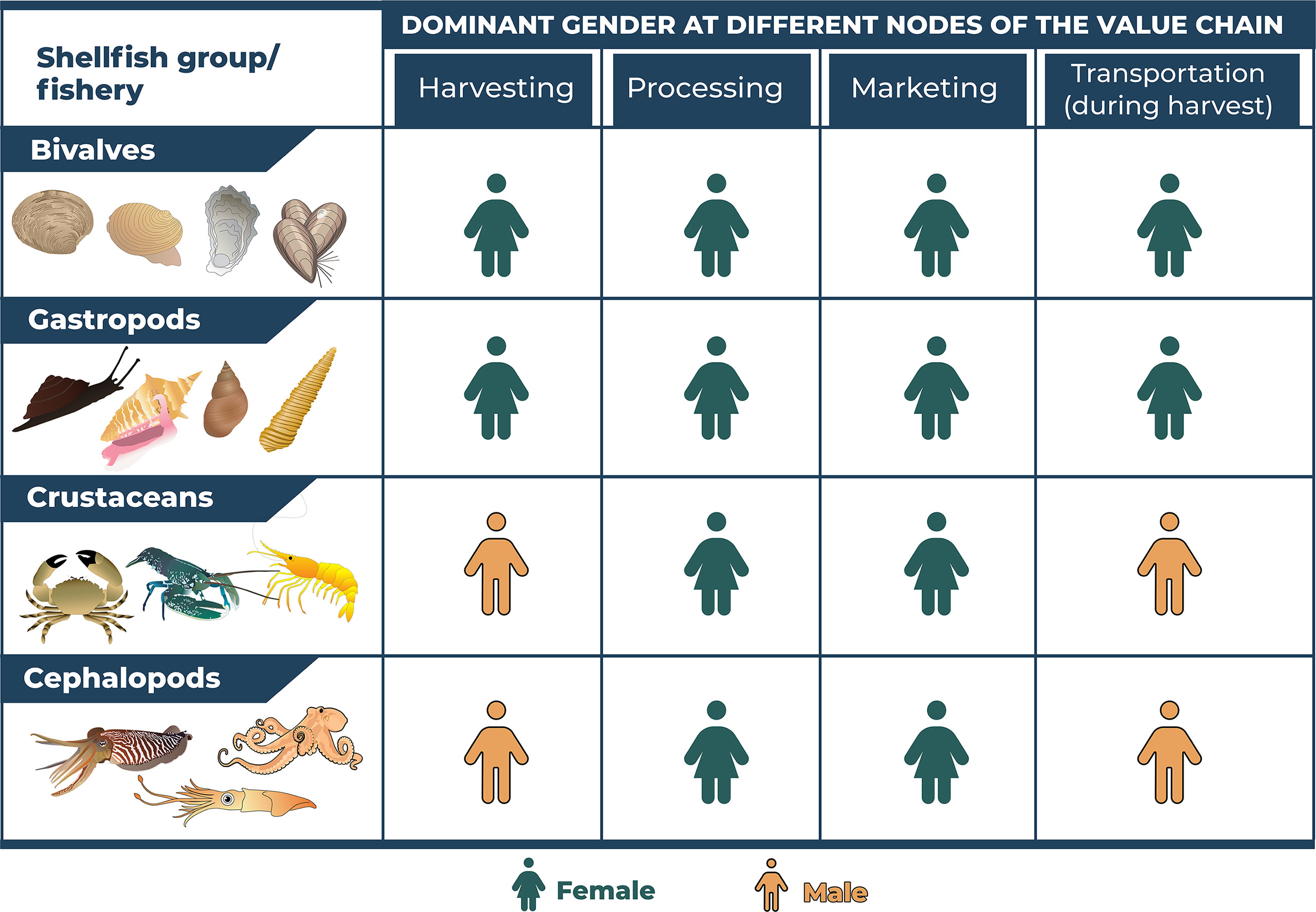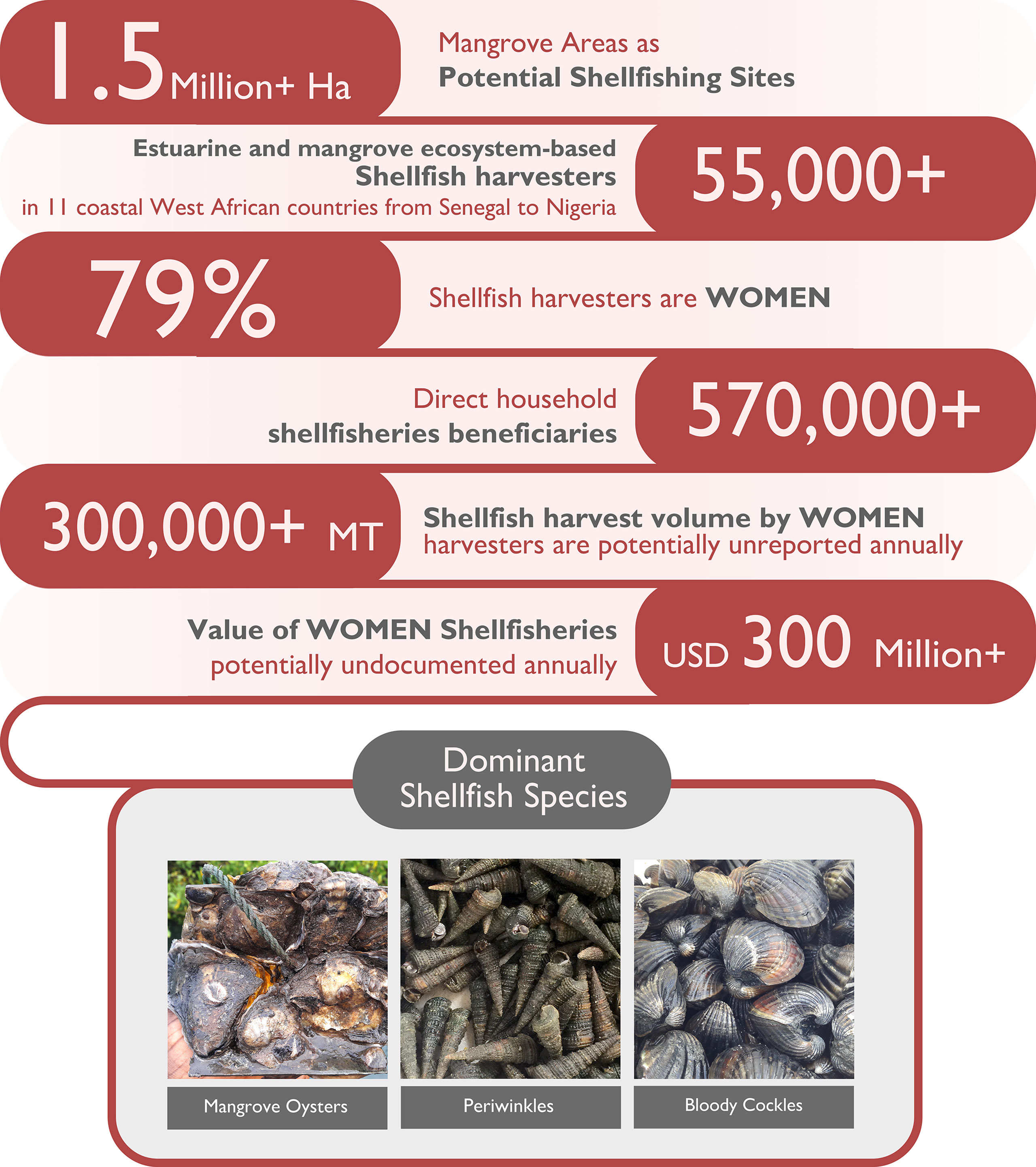Country
Profiles
Country
Networks
Country
Associations
The West Africa Region comprises eleven coastal countries: Senegal, The Gambia, Guinea Bissau, Guinea, Sierra Leone, Liberia, Côte d’Ivoire, Ghana, Togo, Benin, and Nigeria. A recent study across the region highlights shellfisheries conducted by women as an essential livelihood that supports several thousands of households. All the eleven sub-saharan West African coastal countries have active shellfisheries interspersed along their combined 4,472 km coastline. For each country, there are at least four major sites practising shellfish harvesting and trade. This indicates the potential for future efforts for scale-up through direct investments, research, and capacity building, as well as the development of value chains within this industry. Women dominate the shellfisheries livelihoods that occur in the estuarine and mangrove ecosystems of most coastal communities in West Africa, with 79% of shellfishers and value chain actors being women. Among the 11 coastal countries, men’s participation in shellfisheries was highest in Nigeria, where the fishing of crustaceans formed an important component of the artisanal fishery, dominated by males. Nonetheless, the regional overview reveals near total dominance of women along the entire value chain of the bivalve and gastropod shellfisheries, while women also play significant processing and marketing roles in the crustacean and cephalopod shellfisheries.
![Coastal countries of the Economic Community of West African States where estuarine and mangrove ecosystem-based shellfisheries are located. These areas present continental rivers, entering the Atlantic Ocean, with mangrove shores. [The map was developed originally by this study. Data sources: Shellfishing location points from this study; Mangrove data from Global Mangrove Watch; Africa Administrative Level 2 shape file from the Intergovernmental Authority for Development Climate Prediction and Application Centre Geoportal; Rivers data from Diva GIS]. Coastal countries of the Economic Community of West African States](/storage/images/644c73ca-8aed-4b32-a02e-eb7d6c56975a.jpg)
Coastal countries of the Economic Community of West African States where estuarine and mangrove ecosystem-based shellfisheries are located. These areas present continental rivers, entering the Atlantic Ocean, with mangrove shores. Data sources: Shellfishing location points from this study; Mangrove data from Global Mangrove Watch; Africa Administrative Level 2 shape file from the Intergovernmental Authority for Development Climate Prediction and Application Centre Geoportal; Rivers data from Diva GIS]. Image Source: Chuku et al. (2022) |
Most women shellfishers are involved in the sector as a primary form of occupation and the chief source of livelihood and income for their households. However, in most instances, the women were engaged in supplementary livelihood activities to augment their income, especially in the lean seasons for shellfisheries. Empowering these women to enhance their shellfishing livelihoods is, therefore, an important opportunity that could increase their net income and their economic, social, and nutritional well-being. Men involved in shellfisheries largely considered it a secondary occupation to their livelihoods. Their role in the shellfishery was mainly to provide support and was complimentary to the role of the women shellfish harvesters. The total number of people involved directly in shellfish harvesting across the sub-region is estimated conservatively at more than 54,000 individuals, and about 565,695 are estimated to be directly dependent on the resource as members of the households of shellfish harvesters.
Gender dominance of shellfish harvesters along the value chain of different shellfisheries along the West African coast. Gender dominance is determined by more than 60% participation by a particular gender. Source: Chuku et al. (2022) |
A wide range of shellfish species comprising 17 species of molluscs, 11 species of crustaceans, and a few unidentified groups of gastropods, crustaceans and cephalopods are economically important to the region. The West African mangrove oyster, periwinkles, bloody cockle, whelks and razor clams are the most commonly harvested shellfish species. The presence of pearl oysters in West Africa is also documented for the first time with presence in The Gambia and Senegal.
It is challenging to adequately estimate the volume and value of shellfish harvested in the region due to non-standardised vessels for harvesting. Variable sizes of pans, trays, cups, cans, etc., are employed by the harvesters with no measure of weights and no record of sales, making it difficult to deduce estimates of the volume and value of the shellfisheries. That notwithstanding, a conservative estimate puts the total annual shellfish harvest in the region at 301,191 MT, with a potentially unrealised value of about USD 331 million.
The seasonality of harvests is site (ecosystem) and species-specific. The availability of thriving populations of shellfish is the strongest determinant of yields. Where shellfish populations abound, and the pressure is relatively low, harvesting occurs all year round, e.g., in the periwinkle fisheries of the Amissano estuary, Densu delta, and Volta estuary in Ghana.
Summary infographic for the estuarine and mangrove ecosystem-based shellfisheries of West Africa. Chuku et al. (2022) |
The general non-existence of formal laws specific to the regulation of shellfisheries activities within the estuarine and mangrove ecosystems of West Africa calls for efforts to formulate and implement policies on use rights and co-management. It is, however, notable that the women-led shellfisheries of West Africa have seen successful examples of rights-based co-management plans developed and implemented by the resource users themselves with high voluntary compliance and institutionalised in legal and policy documents. These cases are the cockle and oyster co-management plan for the Tanbi Wetlands National Park in The Gambia and the co-management plan for the Densu Delta oyster fishery in Ghana. In the absence of formal laws, traditional norms and customs, as well as locally organised shellfish groups, play an important role in regulating shellfish harvests. These are largely community-based groups, mostly of women shellfish harvesters, that operate in silos within their respective catchments of shellfishing sites. One such group with national coordination is the TRY Oyster Women’s Association of The Gambia which coordinates about 15 satellite formalised community-based women shellfisher groups within the Tanbi wetlands.
Reports
-
-
The Estuarine and Mangrove Ecosystem-Based Shellfisheries of West Africa: Spotlighting Women-Led Fisheries LivelihoodsView Technical Report
-
Participatory Assessment of Shellfisheries in the Estuarine and Mangrove Ecosystems of GhanaView Technical Report
-
Participatory Assessment of Shellfisheries in the Estuarine and Mangrove Ecosystems of The GambiaView Technical Report
-
Participatory Assessment of Shellfisheries in the Estuarine and Mangrove Ecosystems of NigeriaView Technical Report
-
Participatory Assessment of Shellfisheries in the Estuarine and Mangrove Ecosystems of SenegalView Technical Report
-
Participatory Assessment of Shellfisheries in the Estuarine and Mangrove Ecosystems of BeninView Technical Report
-
Participatory Assessment of Shellfisheries in the Estuarine and Mangrove Ecosystems of Côte d’IvoireView Technical Report
-
Participatory Assessment of Shellfisheries in the Estuarine and Mangrove Ecosystems of Guinea-BissauView Technical Report
-
Participatory Assessment of Shellfisheries in the Estuarine and Mangrove Ecosystems of TogoView Technical Report
-
Participatory Assessment of Shellfisheries in the Estuarine and Mangrove Ecosystems of LiberiaView Technical Report
-
Literature Review for the Participatory Regional Assessment of the Shellfisheries in 11 Countries from Senegal to NigeriaView Technical Report
-
Oyster Shellfisheries Locations in Ghana and The GambiaView Technical Report
-
West Africa Women-led Shellfisheries Co-Management in a Global Context: Case Studies From Africa, Asia, and South AmericaView Technical Report
-
Site Based Assessment of Oyster Shellfisheries and Biophysical Conditions in Ghana and The GambiaView Technical Report
-
Value Chain and Economic Analysis of the Shell By- Product of Bivalve Fisheries in Ghana and The Gambia: An Assessment of Oyster, Cockle, and Clam ShellsView Technical Report
-
Multivariate Analysis of the Theory of Change ModelView Technical Report
-
Technical Report on Site Based Research in Ghana and The GambiaLand-seascape Food and Nutrition ProfilesView Technical Report
-
Publications
-
-
Spotlighting Women-Led Fisheries Livelihoods Toward Sustainable Coastal Governance: The Estuarine and Mangrove Ecosystem Shellfisheries of West AfricaView Peer-reviewed Article
-
Mangrove ecosystems mapping in parts of Ghana and The Gambia for sustainable regeneration and utilizationView Peer-reviewed Article
-
Presentations
-
No Presentations
Get started by creating a new presentation.


